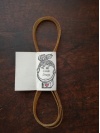The Cordoncini of Rome are strings in lamb or kid whole gut uncut, made - as prescribed by historical sources - with the same technique as those of hemp, that is by twisting three strands made individually by two or more pre-twisted guts in the opposite direction.
The aim is to obtain the maximum elasticity and softness in the medium and bass register, which - if made with simple twisted gut - due to the thickness tend to become rigid and consequently lose the upper harmonics, becoming substantially aphonic and percussive.
Cordedrago uses only whole and very fine sheep guts thanks to a machine specifically designed to reproduce with extreme regularity the execution technique of the hemp ropes, consequently obtaining superficially very regular strings, which require only a light smoothing.
In general, these are strings that were probably made since ancient times, as can be deduced from Roman bas-reliefs and other historical and iconographic sources, but made in the Renaissance and Baroque periods, especially in Rome.
They are particularly suitable for the medium and bass register of Baroque violin, Viola and Cello, Viola da gamba, Oud, Lute, archlute, chitarrone or theorbo and baroque guitar, Romantic guitar and Medieval and ethnic instruments.





